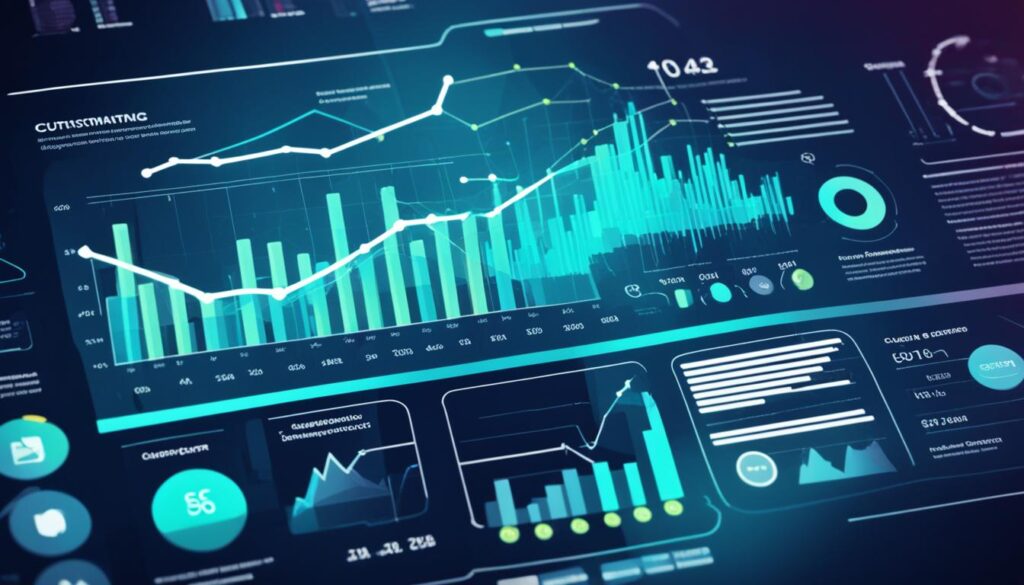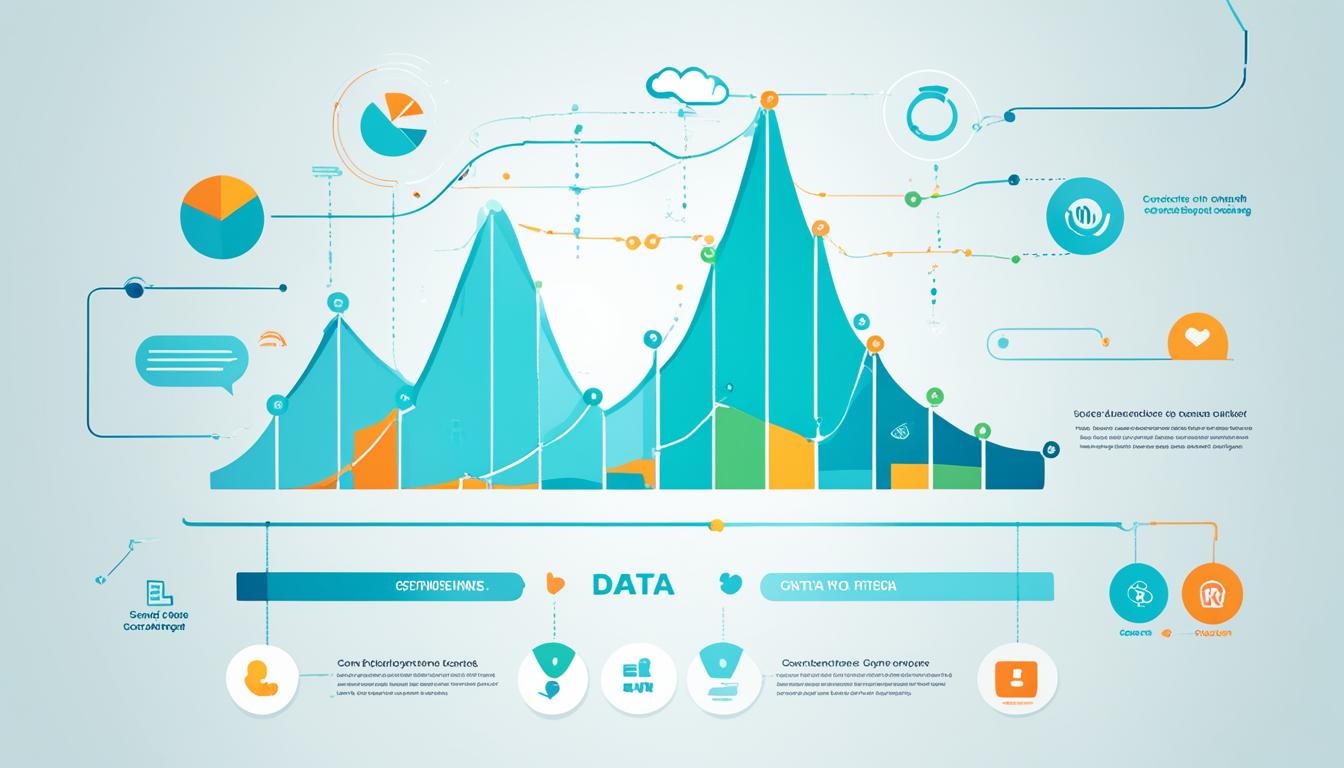Big data has completely transformed the landscape of digital marketing, offering businesses unprecedented opportunities to engage with their customers on a personal level. By harnessing the power of big data and interactive marketing, businesses can create dynamic content that resonates with their target audience, driving customer engagement and loyalty like never before.
Key Takeaways:
- Big data and interactive marketing enable businesses to create personalized experiences for their customers.
- By analyzing large volumes of data, marketers can gain valuable insights into customer behavior and preferences.
- Optimizing campaigns based on data-driven decisions can significantly enhance customer engagement.
- Customer journey mapping allows businesses to identify areas for improvement and optimize the customer experience.
- Predictive analytics based on big data help businesses make informed decisions and stay ahead in the competitive market.
Understanding the Power of Big Data
Big data is a vast collection of information that is generated from various sources such as social media, website analytics, and customer interactions. This wealth of data provides marketers with valuable insights that can drive better decision-making and enhance customer engagement. By harnessing the power of big data, businesses can gain a comprehensive understanding of their target audience, identify emerging trends, and make data-driven decisions that lead to impactful marketing strategies.
One of the significant advantages of big data is its ability to provide valuable insights into customer behavior, preferences, and demographics. By analyzing large volumes of data, marketers can uncover patterns and trends that reveal how customers interact with their products or services. This deep understanding allows marketers to create personalized marketing campaigns that resonate with their audience and deliver targeted content that addresses their specific needs.
With big data, marketers can leverage insights to optimize various aspects of their marketing efforts. They can identify the most effective channels, messaging, and campaign elements through data-driven analysis, ensuring that resources are allocated to the strategies that deliver the highest ROI. Moreover, big data enables marketers to track campaign performance in real-time, providing the agility to make adjustments and optimize campaign effectiveness on the fly.
“Big data is like the new marketing compass that guides businesses towards valuable insights and data-driven decisions.”
By utilizing big data, marketers gain the power to map the customer journey and identify touchpoints that drive engagement and influence purchase decisions. Understanding the customer journey allows marketers to optimize the customer experience by identifying areas for improvement and tailoring their strategies accordingly. By leveraging big data insights, marketers can deliver a seamless and personalized experience at every stage of the customer journey, fostering stronger customer relationships and increasing brand loyalty.
Furthermore, big data opens up new opportunities for predictive analytics and forecasting. By analyzing historical data, marketers can identify market trends and predict future demand patterns. This foresight enables them to allocate resources more effectively, optimize pricing strategies, and launch new products or services with confidence, positioning their businesses for long-term success.
Valuable Insights and Data-Driven Decisions
The power of big data lies in its ability to provide marketers with valuable insights that drive data-driven decision-making. By tapping into the vast pool of data available, businesses can uncover hidden patterns, gain a deep understanding of their target audience, and make informed decisions that lead to more effective marketing campaigns and a competitive edge in the digital landscape.
Next, we will explore in detail how big data enhances customer insights, optimizes campaign effectiveness, and drives business growth in the realm of digital marketing.
Enhancing Customer Insights
Big data analytics enables marketers to gain a comprehensive understanding of their customers by analyzing large volumes of data. Through this process, valuable insights into customer behavior, preferences, and demographics can be uncovered. These insights empower marketers to create personalized marketing campaigns, deliver targeted content, and tailor their offerings to meet customer expectations more effectively.
Gaining Deeper Understanding
By harnessing the power of big data analytics, marketers can delve deeper into customer behavior, unlocking valuable information that allows for a comprehensive understanding of their target audience. This understanding goes beyond surface-level interactions and enables marketers to identify patterns, trends, and preferences that drive customer decision-making.
Optimizing Personalization
Personalized marketing campaigns have become a necessity in today’s competitive landscape. Big data analytics provides the necessary insights to deliver personalized experiences to customers. By leveraging customer behavior data, marketers can craft tailored messages and offers that resonate with their audience. This level of personalization enhances customer engagement and promotes stronger brand loyalty.
Segmentation Strategies
Segmentation is a powerful marketing tool that helps identify specific groups within a target audience. Big data analytics facilitates the creation of precise customer segments based on various attributes such as demographics, interests, and purchasing behavior. This meticulous segmentation allows marketers to develop targeted campaigns that align with the preferences and needs of each segment, resulting in more effective marketing strategies.
Real-Time Insights
Real-time data analysis empowers marketers to gain immediate insights into customer behavior. By analyzing data as it becomes available, marketers can adapt their strategies and campaigns in real-time, ensuring they remain relevant and impactful. This agility allows marketers to seize opportunities, address customer concerns promptly, and optimize their marketing efforts on the go.
Big data analytics enables marketers to uncover valuable insights into customer behavior, preferences, and demographics, empowering them to create personalized marketing campaigns and tailor their offerings to meet customer expectations more effectively.
With the power of big data analytics, marketers have an unprecedented opportunity to gain a deep understanding of their customers. By leveraging customer behavior data and employing advanced analytics techniques, marketers can deliver personalized marketing campaigns, develop effective segmentation strategies, and make data-driven decisions that drive business growth.

Optimizing Campaign Effectiveness
Big data provides marketers with a powerful tool to optimize the effectiveness of their digital marketing campaigns. By leveraging real-time data, marketers can make data-driven decisions to maximize engagement and conversions. Understanding the impact of different strategies and channels enables marketers to allocate resources effectively and refine messaging to resonate with their target audience.
Real-time data allows marketers to track and measure campaign performance in the moment. By analyzing data in real-time, they can gain insights into which strategies and channels are most effective in driving results. This information is invaluable for making informed decisions and optimizing campaign effectiveness.
“Real-time data gives marketers the advantage of agility and adaptability. It allows us to quickly identify what works and what doesn’t, and make the necessary adjustments to improve campaign performance.”
Effective marketing strategies are built on a foundation of data-driven decisions. By utilizing real-time data, marketers can stay ahead of trends and refine their strategies to align with what resonates with their target audience. It enables them to make informed decisions based on data insights, rather than relying on guesswork or assumptions.
Example of Effective Strategies and Channels
Here’s an example of how a company used real-time data to optimize their campaign effectiveness:
| Strategy or Channel | Result |
|---|---|
| Social Media Advertising | 50% increase in website traffic |
| Email Marketing | 30% increase in email open rates |
| Content Marketing | 20% increase in leads generated |
| Search Engine Optimization | 40% increase in organic search traffic |
By analyzing real-time data, the company discovered that their social media advertising and email marketing campaigns were driving significant results. As a result, they reallocated resources to these channels and refined their messaging to further engage their target audience.
Overall, leveraging real-time data allows marketers to optimize their campaigns by making data-driven decisions, reallocating resources to impactful strategies and channels, and refining messaging to resonate with their target audience. It empowers marketers to stay agile, adapt to trends, and maximize the effectiveness of their digital marketing efforts.
Enhancing Customer Journey Mapping
Effective customer journey mapping is crucial for businesses looking to optimize the customer experience and drive brand loyalty. With the power of big data analytics, marketers can gain valuable insights into the customer journey, allowing them to identify touchpoints, improve engagement opportunities, and shape a seamless and tailored experience for their customers.
By mapping customer touchpoints and analyzing data at each stage of the journey, marketers gain a deeper understanding of the customer’s interactions and behaviors. This insight helps uncover potential bottlenecks, areas for improvement, and moments of great significance. By leveraging this data, businesses can refine their strategies and optimize the customer experience, resulting in higher satisfaction levels and increased customer loyalty.
“Optimizing the customer journey is about creating an immersive and personalized experience at every touchpoint. Big data analytics allows businesses to identify pain points and design strategies that deliver value and resonate with customers.”
Understanding the customer journey is not simply about improving a single interaction, but rather about optimizing the entire experience to create meaningful and lasting connections with customers. By analyzing the data obtained from touchpoints such as website visits, social media engagement, customer service interactions, and purchasing behavior, marketers can uncover patterns, preferences, and opportunities for engagement.
In order to optimize the customer experience, businesses should focus on personalization and relevance. By harnessing the power of big data analytics, marketers can understand each individual customer’s needs, preferences, and behavior, allowing them to deliver targeted content and offerings at the right time and through the right channels.
“The customer journey is not a linear path, but rather a complex web of interactions. Big data analytics helps businesses navigate this web by identifying the most impactful touchpoints and optimizing the overall customer experience.”
By optimizing the customer journey, businesses can create memorable experiences that leave a lasting impression on customers, driving repeated engagement and increased brand loyalty. The ability to leverage big data analytics and map the customer journey is a valuable tool for businesses in today’s data-driven era, allowing them to refine their strategies, deliver personalized experiences, and exceed customer expectations.
| Benefits of Enhancing Customer Journey Mapping |
|---|
| Identify potential bottlenecks and areas for improvement |
| Create personalized and tailored experiences |
| Improve targeted engagement opportunities |
| Optimize customer experience and satisfaction |
| Increase brand loyalty and advocacy |

By taking a data-driven approach to customer journey mapping, businesses can optimize every touchpoint and interaction, delivering an exceptional customer experience that sets them apart from the competition. With big data analytics, businesses have the power to gather actionable insights and make informed decisions that optimize the customer journey and drive long-term success.
Predictive Analytics and Forecasting
Big data has revolutionized the way marketers make strategic decisions by leveraging the power of predictive analytics. By analyzing historical data, businesses can gain valuable insights into market trends and demand patterns, enabling them to make accurate forecasts and drive success. Predictive analytics not only allows for a deeper understanding of customer behavior but also provides a competitive advantage in the dynamic digital landscape.
By harnessing the potential of predictive analytics, businesses can allocate resources more effectively and optimize pricing strategies. This data-driven approach empowers marketers to stay one step ahead of the competition and make informed decisions that lead to improved ROI.
Forecasting market trends and demand patterns is essential for businesses to plan ahead and seize opportunities. By analyzing vast amounts of data, marketers can identify emerging trends, anticipate shifts in consumer preferences, and adapt their strategies accordingly. This foresight enhances agility and ensures that businesses are well-prepared to meet customer demands.
Let’s take a closer look at how predictive analytics and forecasting can contribute to a company’s success:
- Accurate Demand Forecasting: Predictive analytics allows businesses to forecast demand accurately, avoiding stockouts or overstocking. By analyzing historical sales data, customer behavior, and market trends, marketers can optimize inventory levels, streamline supply chains, and satisfy customer needs efficiently.
- Optimized Pricing Strategies: Predictive analytics enables businesses to determine optimal pricing strategies by evaluating factors such as market demand, competitor pricing, and customer behavior. By aligning prices with customer expectations and market conditions, companies can maximize profitability and drive revenue growth.
- Proactive Marketing Campaigns: With predictive analytics, marketers can develop proactive marketing campaigns that anticipate customer needs and preferences. By analyzing customer data and behavioral patterns, businesses can personalize messages, target specific segments, and deliver timely and relevant content, driving customer engagement and conversions.

Benefits of Predictive Analytics and Forecasting
| Benefits | Description |
|---|---|
| Improved Resource Allocation | Accurate forecasts enable businesses to allocate resources efficiently, reducing waste and optimizing operational costs. |
| Enhanced Decision-Making | Predictive analytics provides actionable insights that guide informed decision-making, increasing the likelihood of success. |
| Early Identification of Opportunities | By analyzing market trends and demand patterns, businesses can identify emerging opportunities and stay ahead of the competition. |
| Improved Customer Experience | Personalized marketing campaigns based on predictive analytics enhance the customer experience, fostering loyalty and satisfaction. |
In conclusion, the power of predictive analytics and forecasting cannot be underestimated in today’s data-driven era. By leveraging big data, businesses can gain valuable insights into market trends, demand patterns, and customer behavior. This foresight empowers companies to make informed strategic decisions, optimize resource allocation, and stay ahead of the competition.
Conclusion
Big data has transformed the landscape of digital marketing, ushering in a new era of opportunities and possibilities. With its ability to decipher complex consumer behavior and generate valuable insights, big data has become an indispensable tool for businesses seeking to gain a competitive edge in the ever-evolving digital world.
By adopting best practices and harnessing the power of big data, businesses can unlock the full potential of their marketing efforts. From understanding audience preferences and optimizing campaigns to driving business growth, big data empowers marketers to make data-driven decisions that yield tangible results.
In this data-driven era, those who embrace big data will be at an advantage. The ability to leverage customer insights, identify market trends, and predict future demand patterns gives businesses an edge in delivering personalized experiences and targeted messaging. By staying ahead of the curve and adapting to the dynamic digital landscape, businesses can position themselves for success.
FAQ
What is big data and how does it relate to interactive marketing?
Big data refers to the vast amount of information generated from various sources such as social media, website analytics, and customer interactions. It relates to interactive marketing by providing valuable insights into customer behavior, preferences, and demographics, allowing marketers to create personalized marketing campaigns and deliver targeted content.
How does big data analytics enhance customer insights?
By analyzing large volumes of data, big data analytics enables marketers to gain a comprehensive understanding of their customers. This includes insights into customer behavior, preferences, and demographics. With this information, marketers can create personalized marketing campaigns, deliver targeted content, and tailor their offerings to meet customer expectations more effectively.
How does big data help optimize campaign effectiveness?
Big data provides marketers with the ability to track and measure the performance of their digital marketing campaigns in real-time. This allows them to identify the most effective strategies and channels that drive engagement and conversions. With this insight, marketers can optimize their campaigns, reallocate resources to impactful channels, and refine messaging to resonate with the target audience.
How can big data enhance customer journey mapping?
By mapping customer touchpoints and analyzing data at each stage, big data enables marketers to gain a deeper understanding of the customer journey. This helps identify potential bottlenecks, areas for improvement, and opportunities for engagement. By optimizing the customer experience based on this insight, marketers can increase satisfaction and foster brand loyalty.
What is the role of predictive analytics and forecasting in big data?
Big data empowers marketers to make predictions and forecasts based on historical data. By leveraging predictive analytics, marketers can anticipate customer behavior, market trends, and demand patterns. This foresight enables them to allocate resources more effectively, optimize pricing strategies, and launch new products or services with greater confidence.








